Operational Budgets: Analysis, Types, and Financial Statements
VerifiedAdded on 2020/12/18
|16
|4737
|131
Report
AI Summary
This report provides a comprehensive overview of operational budgets, encompassing various aspects of financial planning and analysis. It begins with an introduction to budgets, their significance, and the different types, including master, static, and sales budgets, along with budgetary control principles. The report emphasizes the importance of discussing budgets with colleagues and peers for effective planning and covers the preparation of budgeted profit and loss statements. It delves into practical examples, such as sales, purchase, and cash budgets, providing detailed calculations and working notes. Furthermore, the report includes variance analysis, forecasting techniques, and a discussion on double-entry accounting, offering a holistic understanding of financial management. The report also features a presentation on the same topics, enhancing the learning experience.
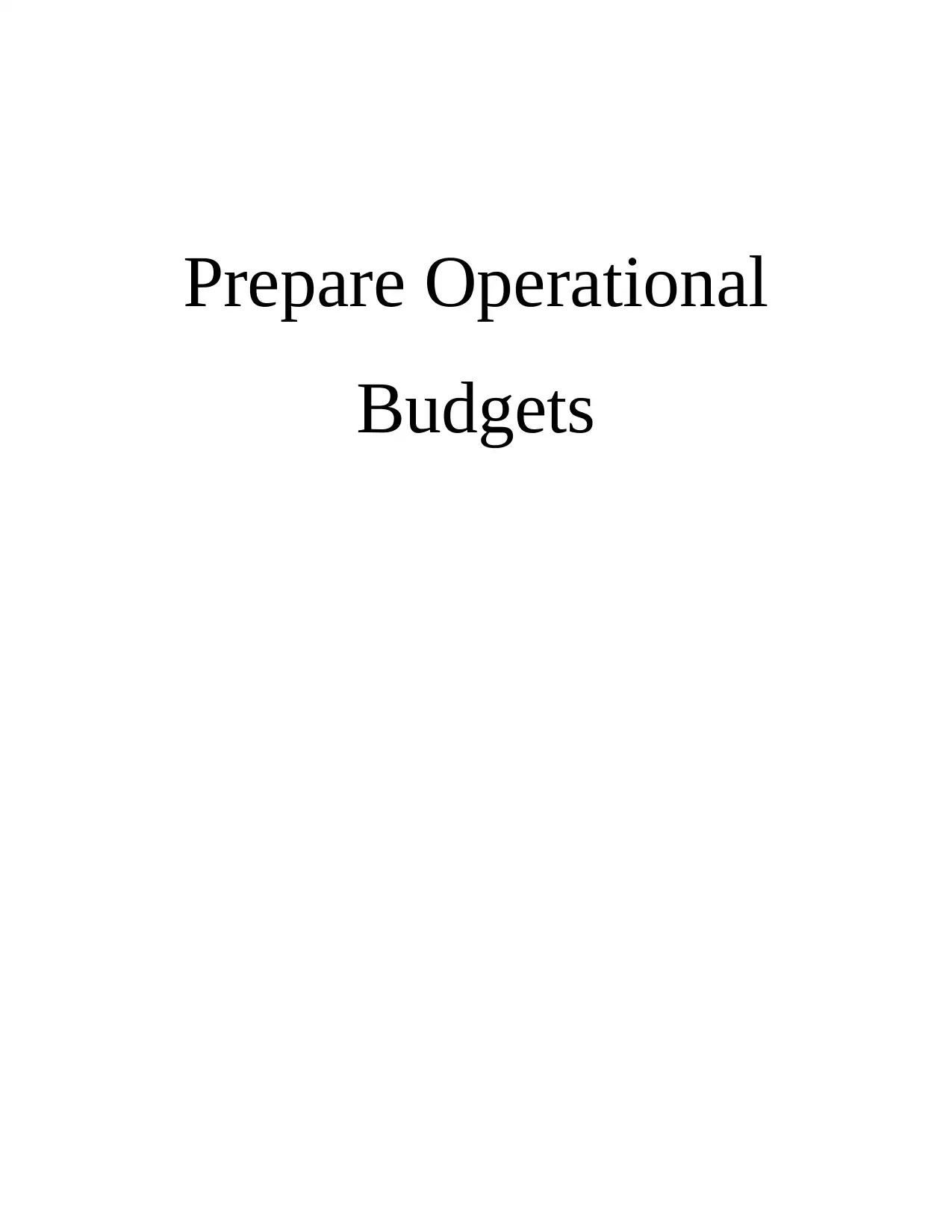
Prepare Operational
Budgets
Budgets
Paraphrase This Document
Need a fresh take? Get an instant paraphrase of this document with our AI Paraphraser
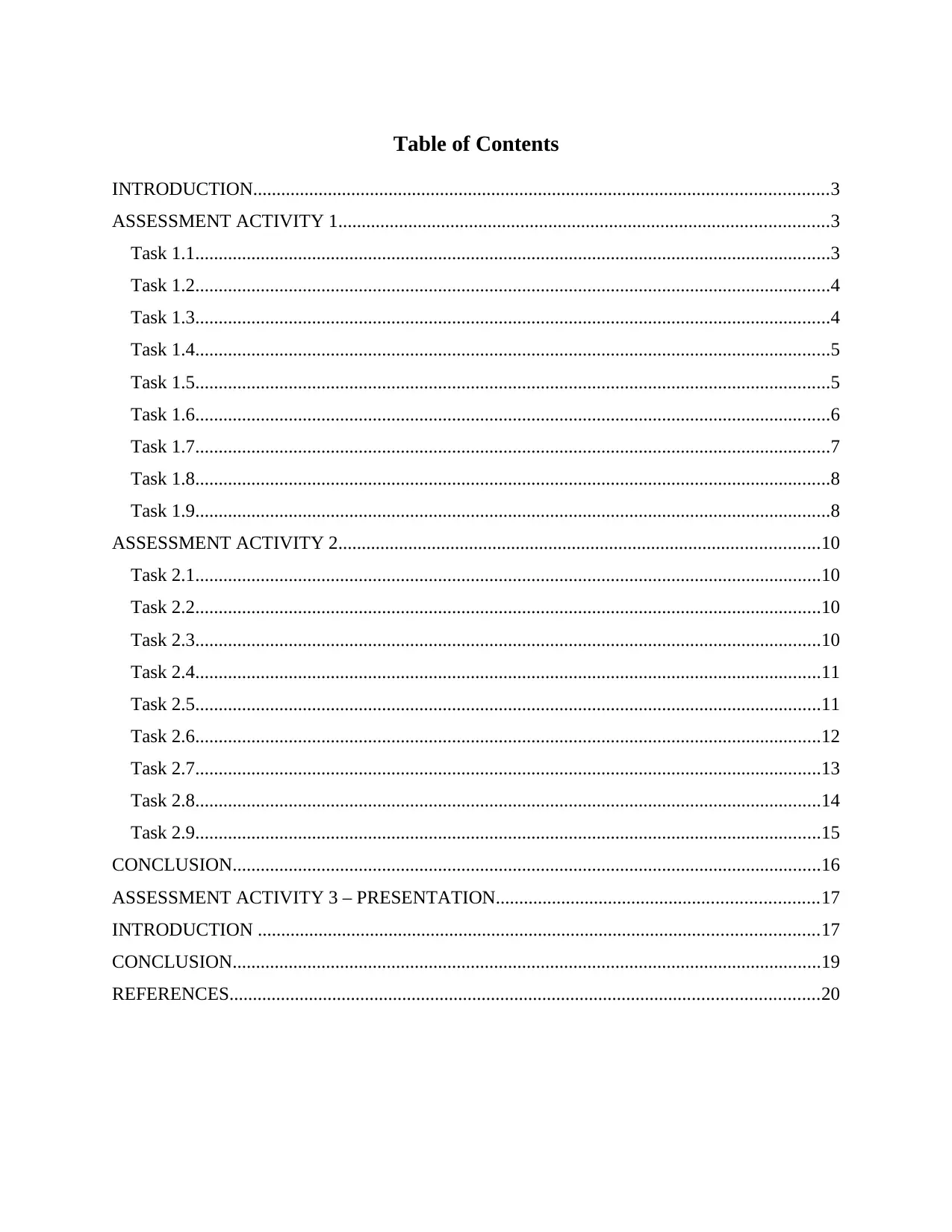
Table of Contents
INTRODUCTION...........................................................................................................................3
ASSESSMENT ACTIVITY 1.........................................................................................................3
Task 1.1........................................................................................................................................3
Task 1.2........................................................................................................................................4
Task 1.3........................................................................................................................................4
Task 1.4........................................................................................................................................5
Task 1.5........................................................................................................................................5
Task 1.6........................................................................................................................................6
Task 1.7........................................................................................................................................7
Task 1.8........................................................................................................................................8
Task 1.9........................................................................................................................................8
ASSESSMENT ACTIVITY 2.......................................................................................................10
Task 2.1......................................................................................................................................10
Task 2.2......................................................................................................................................10
Task 2.3......................................................................................................................................10
Task 2.4......................................................................................................................................11
Task 2.5......................................................................................................................................11
Task 2.6......................................................................................................................................12
Task 2.7......................................................................................................................................13
Task 2.8......................................................................................................................................14
Task 2.9......................................................................................................................................15
CONCLUSION..............................................................................................................................16
ASSESSMENT ACTIVITY 3 – PRESENTATION.....................................................................17
INTRODUCTION ........................................................................................................................17
CONCLUSION..............................................................................................................................19
REFERENCES..............................................................................................................................20
INTRODUCTION...........................................................................................................................3
ASSESSMENT ACTIVITY 1.........................................................................................................3
Task 1.1........................................................................................................................................3
Task 1.2........................................................................................................................................4
Task 1.3........................................................................................................................................4
Task 1.4........................................................................................................................................5
Task 1.5........................................................................................................................................5
Task 1.6........................................................................................................................................6
Task 1.7........................................................................................................................................7
Task 1.8........................................................................................................................................8
Task 1.9........................................................................................................................................8
ASSESSMENT ACTIVITY 2.......................................................................................................10
Task 2.1......................................................................................................................................10
Task 2.2......................................................................................................................................10
Task 2.3......................................................................................................................................10
Task 2.4......................................................................................................................................11
Task 2.5......................................................................................................................................11
Task 2.6......................................................................................................................................12
Task 2.7......................................................................................................................................13
Task 2.8......................................................................................................................................14
Task 2.9......................................................................................................................................15
CONCLUSION..............................................................................................................................16
ASSESSMENT ACTIVITY 3 – PRESENTATION.....................................................................17
INTRODUCTION ........................................................................................................................17
CONCLUSION..............................................................................................................................19
REFERENCES..............................................................................................................................20
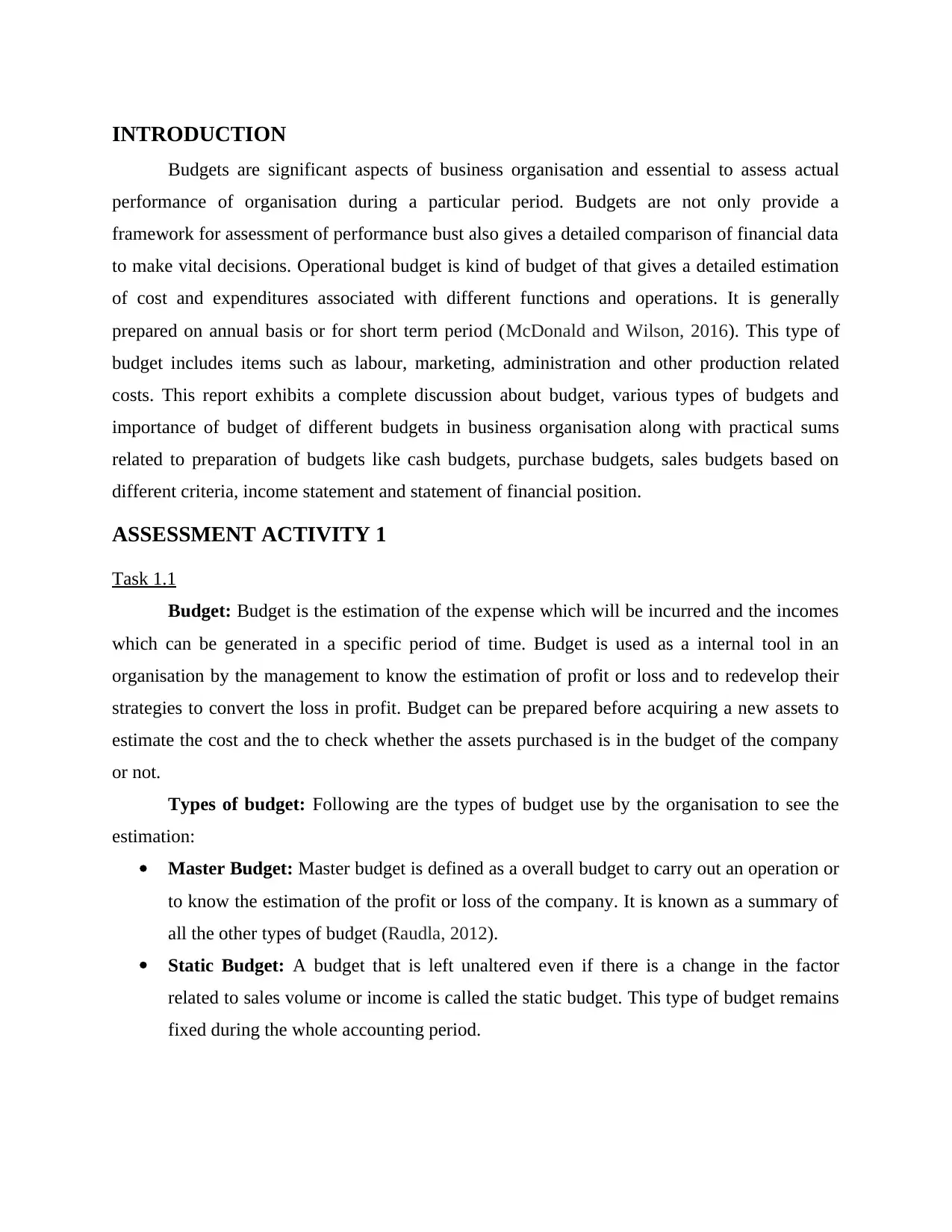
INTRODUCTION
Budgets are significant aspects of business organisation and essential to assess actual
performance of organisation during a particular period. Budgets are not only provide a
framework for assessment of performance bust also gives a detailed comparison of financial data
to make vital decisions. Operational budget is kind of budget of that gives a detailed estimation
of cost and expenditures associated with different functions and operations. It is generally
prepared on annual basis or for short term period (McDonald and Wilson, 2016). This type of
budget includes items such as labour, marketing, administration and other production related
costs. This report exhibits a complete discussion about budget, various types of budgets and
importance of budget of different budgets in business organisation along with practical sums
related to preparation of budgets like cash budgets, purchase budgets, sales budgets based on
different criteria, income statement and statement of financial position.
ASSESSMENT ACTIVITY 1
Task 1.1
Budget: Budget is the estimation of the expense which will be incurred and the incomes
which can be generated in a specific period of time. Budget is used as a internal tool in an
organisation by the management to know the estimation of profit or loss and to redevelop their
strategies to convert the loss in profit. Budget can be prepared before acquiring a new assets to
estimate the cost and the to check whether the assets purchased is in the budget of the company
or not.
Types of budget: Following are the types of budget use by the organisation to see the
estimation:
Master Budget: Master budget is defined as a overall budget to carry out an operation or
to know the estimation of the profit or loss of the company. It is known as a summary of
all the other types of budget (Raudla, 2012).
Static Budget: A budget that is left unaltered even if there is a change in the factor
related to sales volume or income is called the static budget. This type of budget remains
fixed during the whole accounting period.
Budgets are significant aspects of business organisation and essential to assess actual
performance of organisation during a particular period. Budgets are not only provide a
framework for assessment of performance bust also gives a detailed comparison of financial data
to make vital decisions. Operational budget is kind of budget of that gives a detailed estimation
of cost and expenditures associated with different functions and operations. It is generally
prepared on annual basis or for short term period (McDonald and Wilson, 2016). This type of
budget includes items such as labour, marketing, administration and other production related
costs. This report exhibits a complete discussion about budget, various types of budgets and
importance of budget of different budgets in business organisation along with practical sums
related to preparation of budgets like cash budgets, purchase budgets, sales budgets based on
different criteria, income statement and statement of financial position.
ASSESSMENT ACTIVITY 1
Task 1.1
Budget: Budget is the estimation of the expense which will be incurred and the incomes
which can be generated in a specific period of time. Budget is used as a internal tool in an
organisation by the management to know the estimation of profit or loss and to redevelop their
strategies to convert the loss in profit. Budget can be prepared before acquiring a new assets to
estimate the cost and the to check whether the assets purchased is in the budget of the company
or not.
Types of budget: Following are the types of budget use by the organisation to see the
estimation:
Master Budget: Master budget is defined as a overall budget to carry out an operation or
to know the estimation of the profit or loss of the company. It is known as a summary of
all the other types of budget (Raudla, 2012).
Static Budget: A budget that is left unaltered even if there is a change in the factor
related to sales volume or income is called the static budget. This type of budget remains
fixed during the whole accounting period.
⊘ This is a preview!⊘
Do you want full access?
Subscribe today to unlock all pages.

Trusted by 1+ million students worldwide
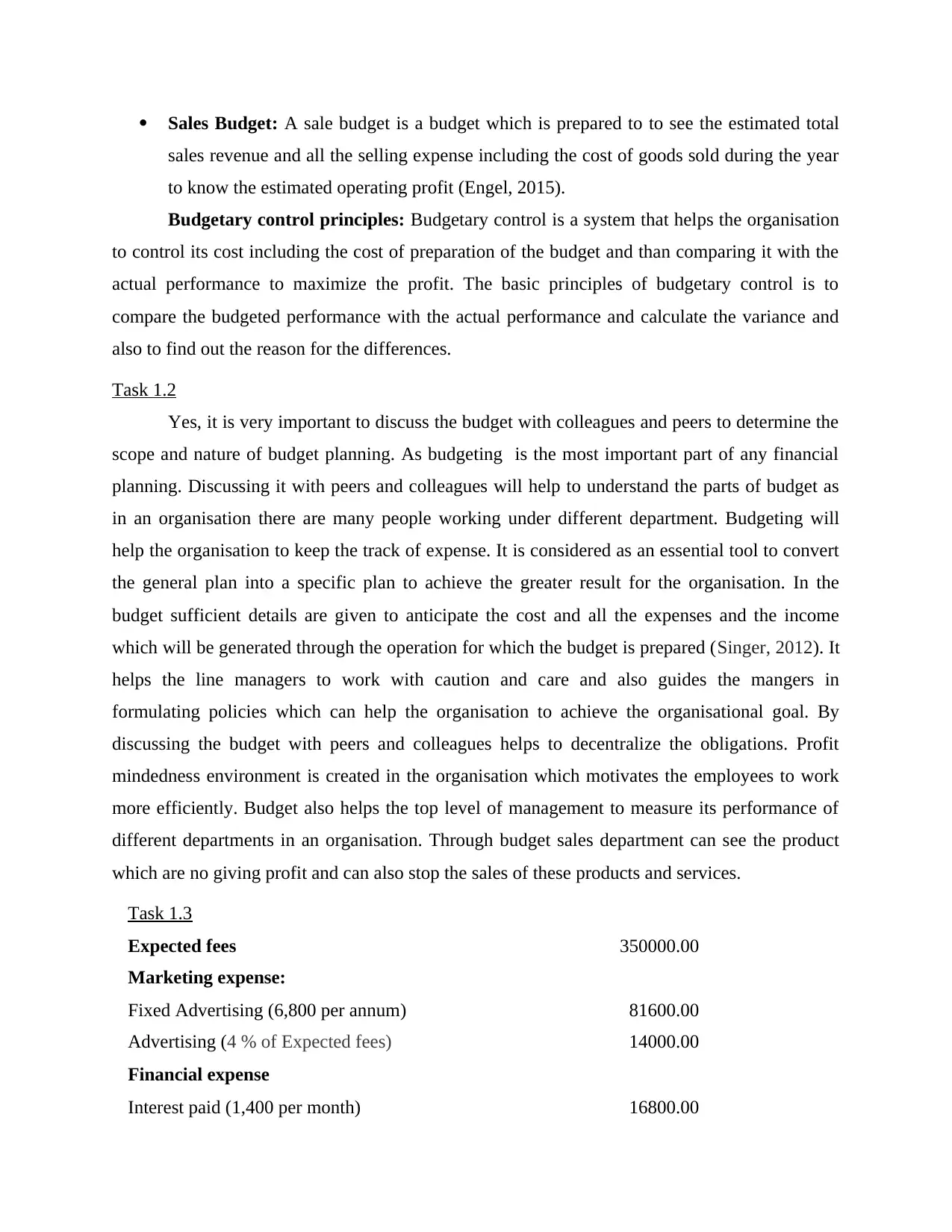
Sales Budget: A sale budget is a budget which is prepared to to see the estimated total
sales revenue and all the selling expense including the cost of goods sold during the year
to know the estimated operating profit (Engel, 2015).
Budgetary control principles: Budgetary control is a system that helps the organisation
to control its cost including the cost of preparation of the budget and than comparing it with the
actual performance to maximize the profit. The basic principles of budgetary control is to
compare the budgeted performance with the actual performance and calculate the variance and
also to find out the reason for the differences.
Task 1.2
Yes, it is very important to discuss the budget with colleagues and peers to determine the
scope and nature of budget planning. As budgeting is the most important part of any financial
planning. Discussing it with peers and colleagues will help to understand the parts of budget as
in an organisation there are many people working under different department. Budgeting will
help the organisation to keep the track of expense. It is considered as an essential tool to convert
the general plan into a specific plan to achieve the greater result for the organisation. In the
budget sufficient details are given to anticipate the cost and all the expenses and the income
which will be generated through the operation for which the budget is prepared (Singer, 2012). It
helps the line managers to work with caution and care and also guides the mangers in
formulating policies which can help the organisation to achieve the organisational goal. By
discussing the budget with peers and colleagues helps to decentralize the obligations. Profit
mindedness environment is created in the organisation which motivates the employees to work
more efficiently. Budget also helps the top level of management to measure its performance of
different departments in an organisation. Through budget sales department can see the product
which are no giving profit and can also stop the sales of these products and services.
Task 1.3
Expected fees 350000.00
Marketing expense:
Fixed Advertising (6,800 per annum) 81600.00
Advertising (4 % of Expected fees) 14000.00
Financial expense
Interest paid (1,400 per month) 16800.00
sales revenue and all the selling expense including the cost of goods sold during the year
to know the estimated operating profit (Engel, 2015).
Budgetary control principles: Budgetary control is a system that helps the organisation
to control its cost including the cost of preparation of the budget and than comparing it with the
actual performance to maximize the profit. The basic principles of budgetary control is to
compare the budgeted performance with the actual performance and calculate the variance and
also to find out the reason for the differences.
Task 1.2
Yes, it is very important to discuss the budget with colleagues and peers to determine the
scope and nature of budget planning. As budgeting is the most important part of any financial
planning. Discussing it with peers and colleagues will help to understand the parts of budget as
in an organisation there are many people working under different department. Budgeting will
help the organisation to keep the track of expense. It is considered as an essential tool to convert
the general plan into a specific plan to achieve the greater result for the organisation. In the
budget sufficient details are given to anticipate the cost and all the expenses and the income
which will be generated through the operation for which the budget is prepared (Singer, 2012). It
helps the line managers to work with caution and care and also guides the mangers in
formulating policies which can help the organisation to achieve the organisational goal. By
discussing the budget with peers and colleagues helps to decentralize the obligations. Profit
mindedness environment is created in the organisation which motivates the employees to work
more efficiently. Budget also helps the top level of management to measure its performance of
different departments in an organisation. Through budget sales department can see the product
which are no giving profit and can also stop the sales of these products and services.
Task 1.3
Expected fees 350000.00
Marketing expense:
Fixed Advertising (6,800 per annum) 81600.00
Advertising (4 % of Expected fees) 14000.00
Financial expense
Interest paid (1,400 per month) 16800.00
Paraphrase This Document
Need a fresh take? Get an instant paraphrase of this document with our AI Paraphraser
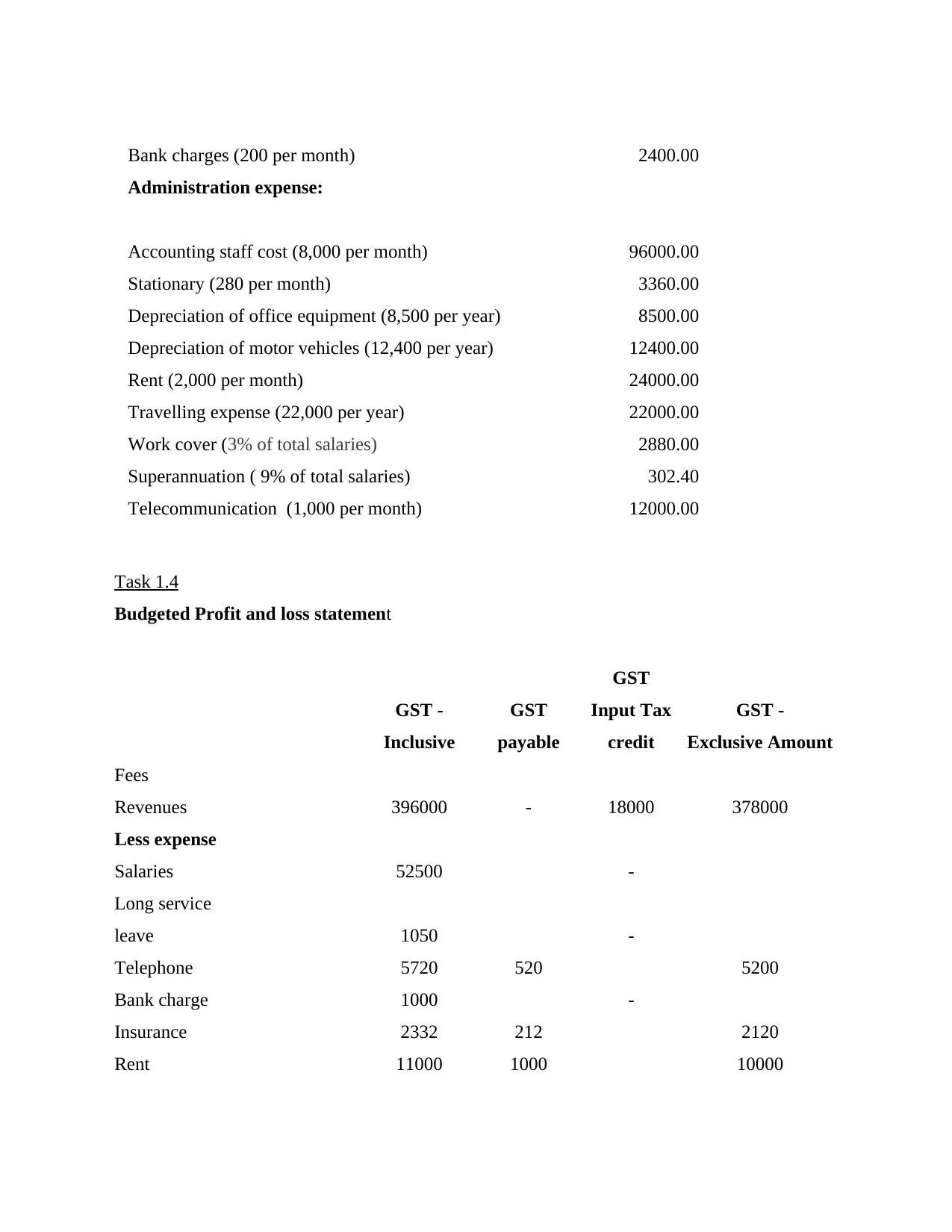
Bank charges (200 per month) 2400.00
Administration expense:
Accounting staff cost (8,000 per month) 96000.00
Stationary (280 per month) 3360.00
Depreciation of office equipment (8,500 per year) 8500.00
Depreciation of motor vehicles (12,400 per year) 12400.00
Rent (2,000 per month) 24000.00
Travelling expense (22,000 per year) 22000.00
Work cover (3% of total salaries) 2880.00
Superannuation ( 9% of total salaries) 302.40
Telecommunication (1,000 per month) 12000.00
Task 1.4
Budgeted Profit and loss statement
GST -
Inclusive
GST
payable
GST
Input Tax
credit
GST -
Exclusive Amount
Fees
Revenues 396000 - 18000 378000
Less expense
Salaries 52500 -
Long service
leave 1050 -
Telephone 5720 520 5200
Bank charge 1000 -
Insurance 2332 212 2120
Rent 11000 1000 10000
Administration expense:
Accounting staff cost (8,000 per month) 96000.00
Stationary (280 per month) 3360.00
Depreciation of office equipment (8,500 per year) 8500.00
Depreciation of motor vehicles (12,400 per year) 12400.00
Rent (2,000 per month) 24000.00
Travelling expense (22,000 per year) 22000.00
Work cover (3% of total salaries) 2880.00
Superannuation ( 9% of total salaries) 302.40
Telecommunication (1,000 per month) 12000.00
Task 1.4
Budgeted Profit and loss statement
GST -
Inclusive
GST
payable
GST
Input Tax
credit
GST -
Exclusive Amount
Fees
Revenues 396000 - 18000 378000
Less expense
Salaries 52500 -
Long service
leave 1050 -
Telephone 5720 520 5200
Bank charge 1000 -
Insurance 2332 212 2120
Rent 11000 1000 10000
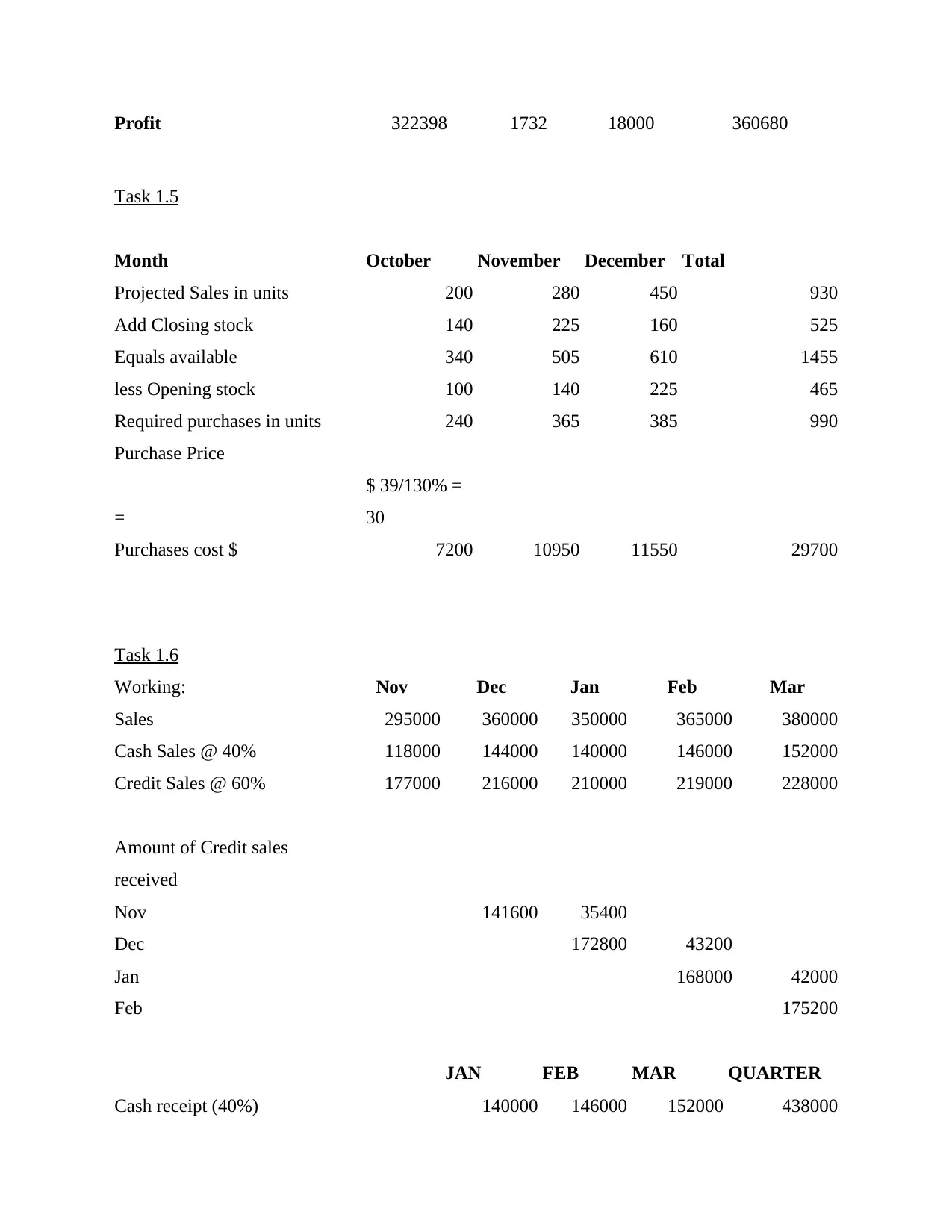
Profit 322398 1732 18000 360680
Task 1.5
Month October November December Total
Projected Sales in units 200 280 450 930
Add Closing stock 140 225 160 525
Equals available 340 505 610 1455
less Opening stock 100 140 225 465
Required purchases in units 240 365 385 990
Purchase Price
=
$ 39/130% =
30
Purchases cost $ 7200 10950 11550 29700
Task 1.6
Working: Nov Dec Jan Feb Mar
Sales 295000 360000 350000 365000 380000
Cash Sales @ 40% 118000 144000 140000 146000 152000
Credit Sales @ 60% 177000 216000 210000 219000 228000
Amount of Credit sales
received
Nov 141600 35400
Dec 172800 43200
Jan 168000 42000
Feb 175200
JAN FEB MAR QUARTER
Cash receipt (40%) 140000 146000 152000 438000
Task 1.5
Month October November December Total
Projected Sales in units 200 280 450 930
Add Closing stock 140 225 160 525
Equals available 340 505 610 1455
less Opening stock 100 140 225 465
Required purchases in units 240 365 385 990
Purchase Price
=
$ 39/130% =
30
Purchases cost $ 7200 10950 11550 29700
Task 1.6
Working: Nov Dec Jan Feb Mar
Sales 295000 360000 350000 365000 380000
Cash Sales @ 40% 118000 144000 140000 146000 152000
Credit Sales @ 60% 177000 216000 210000 219000 228000
Amount of Credit sales
received
Nov 141600 35400
Dec 172800 43200
Jan 168000 42000
Feb 175200
JAN FEB MAR QUARTER
Cash receipt (40%) 140000 146000 152000 438000
⊘ This is a preview!⊘
Do you want full access?
Subscribe today to unlock all pages.

Trusted by 1+ million students worldwide
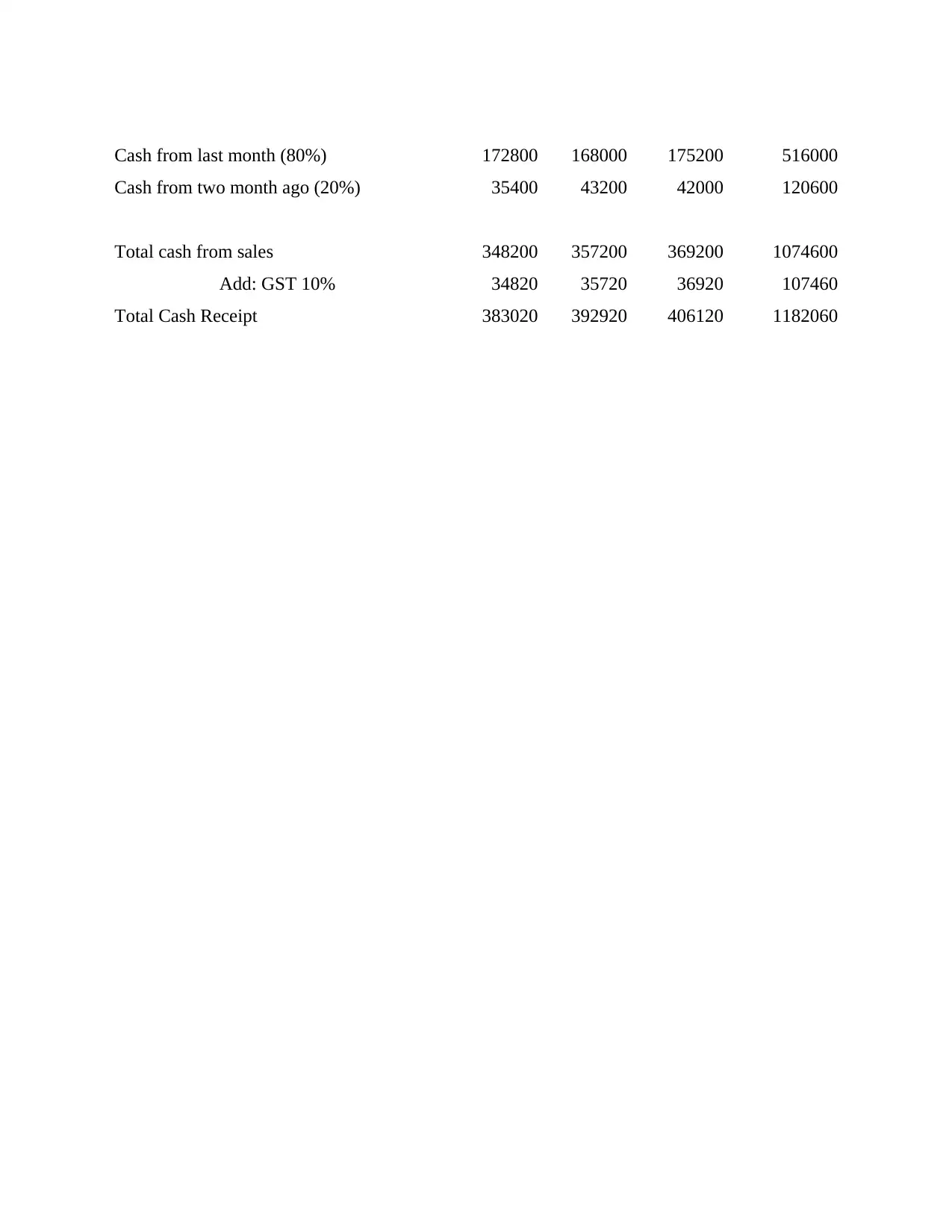
Cash from last month (80%) 172800 168000 175200 516000
Cash from two month ago (20%) 35400 43200 42000 120600
Total cash from sales 348200 357200 369200 1074600
Add: GST 10% 34820 35720 36920 107460
Total Cash Receipt 383020 392920 406120 1182060
Cash from two month ago (20%) 35400 43200 42000 120600
Total cash from sales 348200 357200 369200 1074600
Add: GST 10% 34820 35720 36920 107460
Total Cash Receipt 383020 392920 406120 1182060
Paraphrase This Document
Need a fresh take? Get an instant paraphrase of this document with our AI Paraphraser
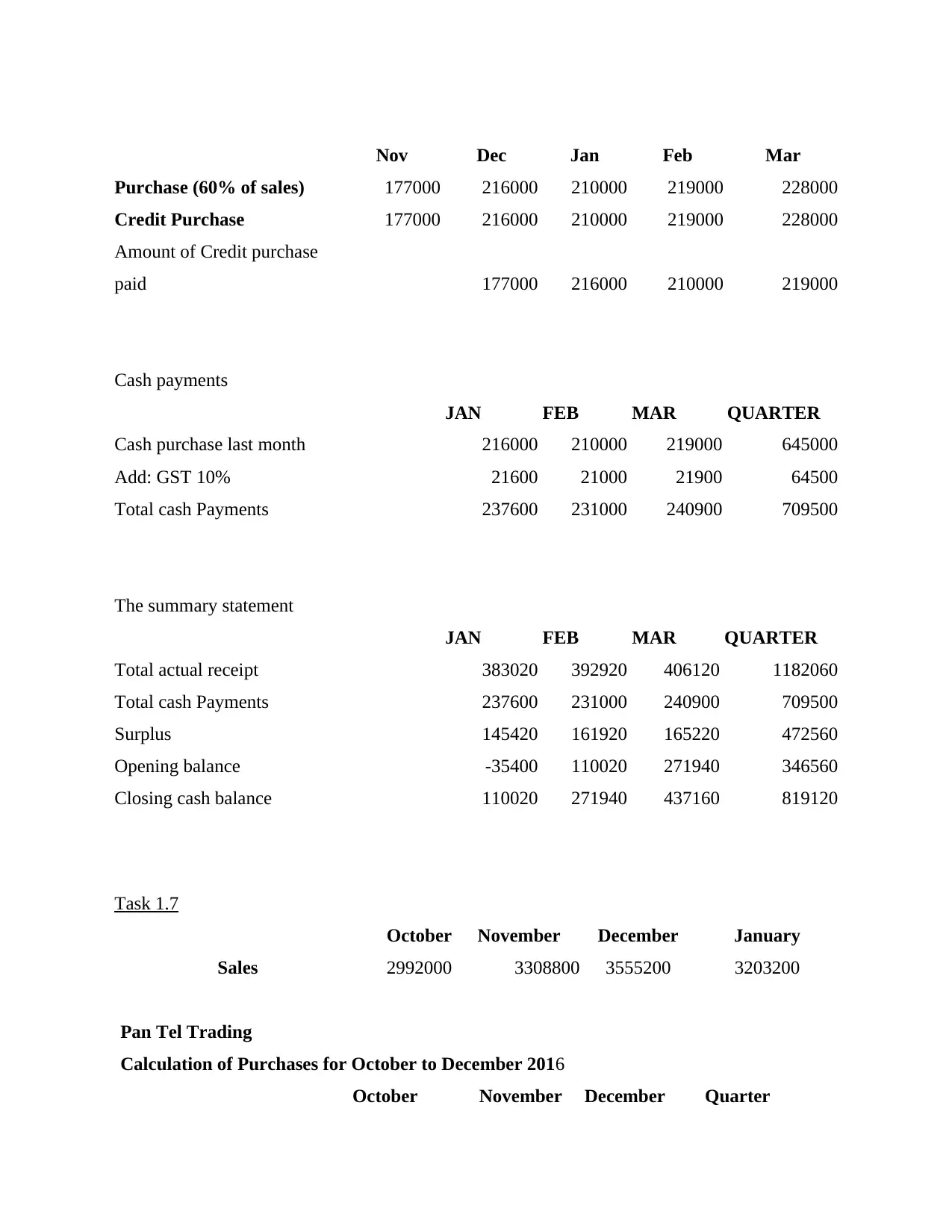
Nov Dec Jan Feb Mar
Purchase (60% of sales) 177000 216000 210000 219000 228000
Credit Purchase 177000 216000 210000 219000 228000
Amount of Credit purchase
paid 177000 216000 210000 219000
Cash payments
JAN FEB MAR QUARTER
Cash purchase last month 216000 210000 219000 645000
Add: GST 10% 21600 21000 21900 64500
Total cash Payments 237600 231000 240900 709500
The summary statement
JAN FEB MAR QUARTER
Total actual receipt 383020 392920 406120 1182060
Total cash Payments 237600 231000 240900 709500
Surplus 145420 161920 165220 472560
Opening balance -35400 110020 271940 346560
Closing cash balance 110020 271940 437160 819120
Task 1.7
October November December January
Sales 2992000 3308800 3555200 3203200
Pan Tel Trading
Calculation of Purchases for October to December 2016
October November December Quarter
Purchase (60% of sales) 177000 216000 210000 219000 228000
Credit Purchase 177000 216000 210000 219000 228000
Amount of Credit purchase
paid 177000 216000 210000 219000
Cash payments
JAN FEB MAR QUARTER
Cash purchase last month 216000 210000 219000 645000
Add: GST 10% 21600 21000 21900 64500
Total cash Payments 237600 231000 240900 709500
The summary statement
JAN FEB MAR QUARTER
Total actual receipt 383020 392920 406120 1182060
Total cash Payments 237600 231000 240900 709500
Surplus 145420 161920 165220 472560
Opening balance -35400 110020 271940 346560
Closing cash balance 110020 271940 437160 819120
Task 1.7
October November December January
Sales 2992000 3308800 3555200 3203200
Pan Tel Trading
Calculation of Purchases for October to December 2016
October November December Quarter
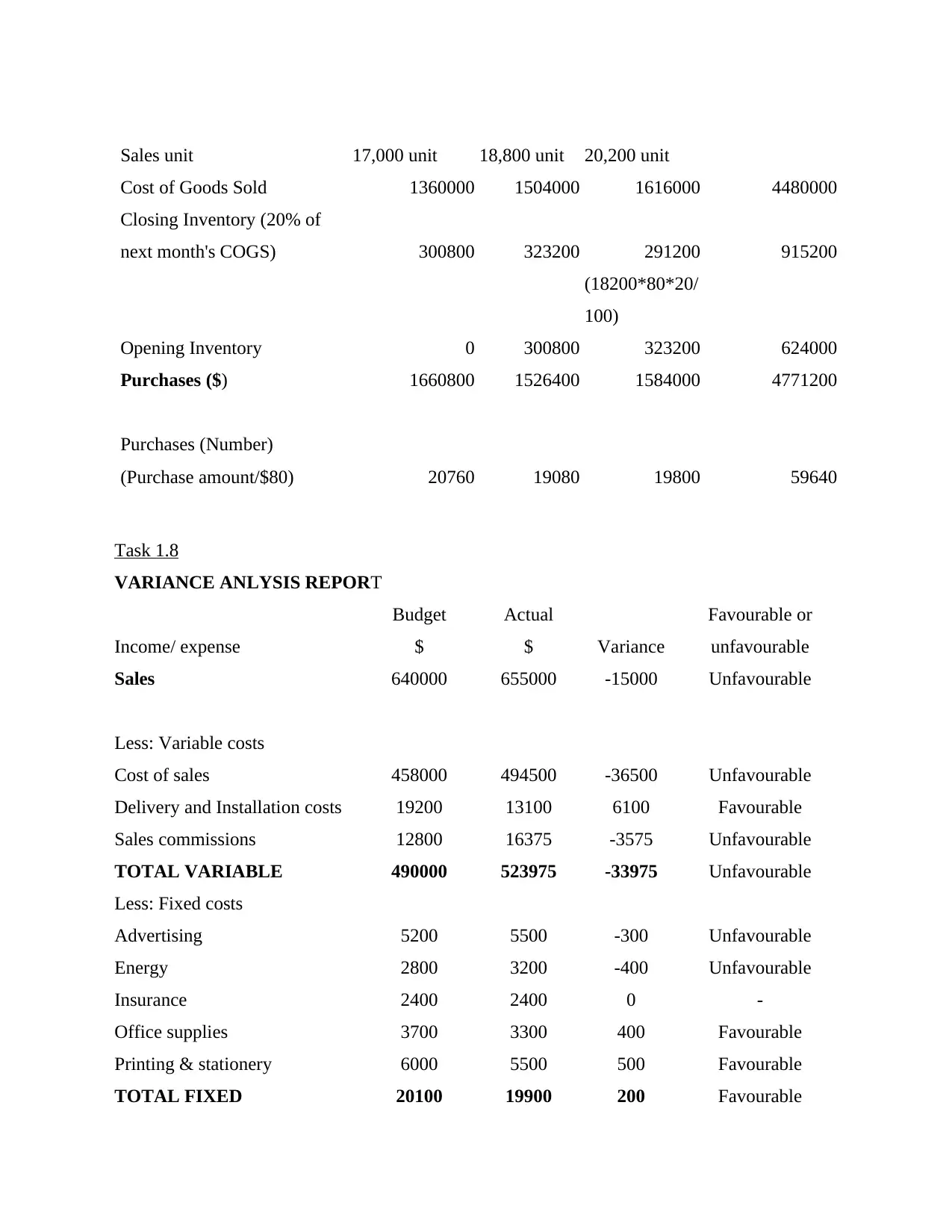
Sales unit 17,000 unit 18,800 unit 20,200 unit
Cost of Goods Sold 1360000 1504000 1616000 4480000
Closing Inventory (20% of
next month's COGS) 300800 323200 291200 915200
(18200*80*20/
100)
Opening Inventory 0 300800 323200 624000
Purchases ($) 1660800 1526400 1584000 4771200
Purchases (Number)
(Purchase amount/$80) 20760 19080 19800 59640
Task 1.8
VARIANCE ANLYSIS REPORT
Income/ expense
Budget
$
Actual
$ Variance
Favourable or
unfavourable
Sales 640000 655000 -15000 Unfavourable
Less: Variable costs
Cost of sales 458000 494500 -36500 Unfavourable
Delivery and Installation costs 19200 13100 6100 Favourable
Sales commissions 12800 16375 -3575 Unfavourable
TOTAL VARIABLE 490000 523975 -33975 Unfavourable
Less: Fixed costs
Advertising 5200 5500 -300 Unfavourable
Energy 2800 3200 -400 Unfavourable
Insurance 2400 2400 0 -
Office supplies 3700 3300 400 Favourable
Printing & stationery 6000 5500 500 Favourable
TOTAL FIXED 20100 19900 200 Favourable
Cost of Goods Sold 1360000 1504000 1616000 4480000
Closing Inventory (20% of
next month's COGS) 300800 323200 291200 915200
(18200*80*20/
100)
Opening Inventory 0 300800 323200 624000
Purchases ($) 1660800 1526400 1584000 4771200
Purchases (Number)
(Purchase amount/$80) 20760 19080 19800 59640
Task 1.8
VARIANCE ANLYSIS REPORT
Income/ expense
Budget
$
Actual
$ Variance
Favourable or
unfavourable
Sales 640000 655000 -15000 Unfavourable
Less: Variable costs
Cost of sales 458000 494500 -36500 Unfavourable
Delivery and Installation costs 19200 13100 6100 Favourable
Sales commissions 12800 16375 -3575 Unfavourable
TOTAL VARIABLE 490000 523975 -33975 Unfavourable
Less: Fixed costs
Advertising 5200 5500 -300 Unfavourable
Energy 2800 3200 -400 Unfavourable
Insurance 2400 2400 0 -
Office supplies 3700 3300 400 Favourable
Printing & stationery 6000 5500 500 Favourable
TOTAL FIXED 20100 19900 200 Favourable
⊘ This is a preview!⊘
Do you want full access?
Subscribe today to unlock all pages.

Trusted by 1+ million students worldwide
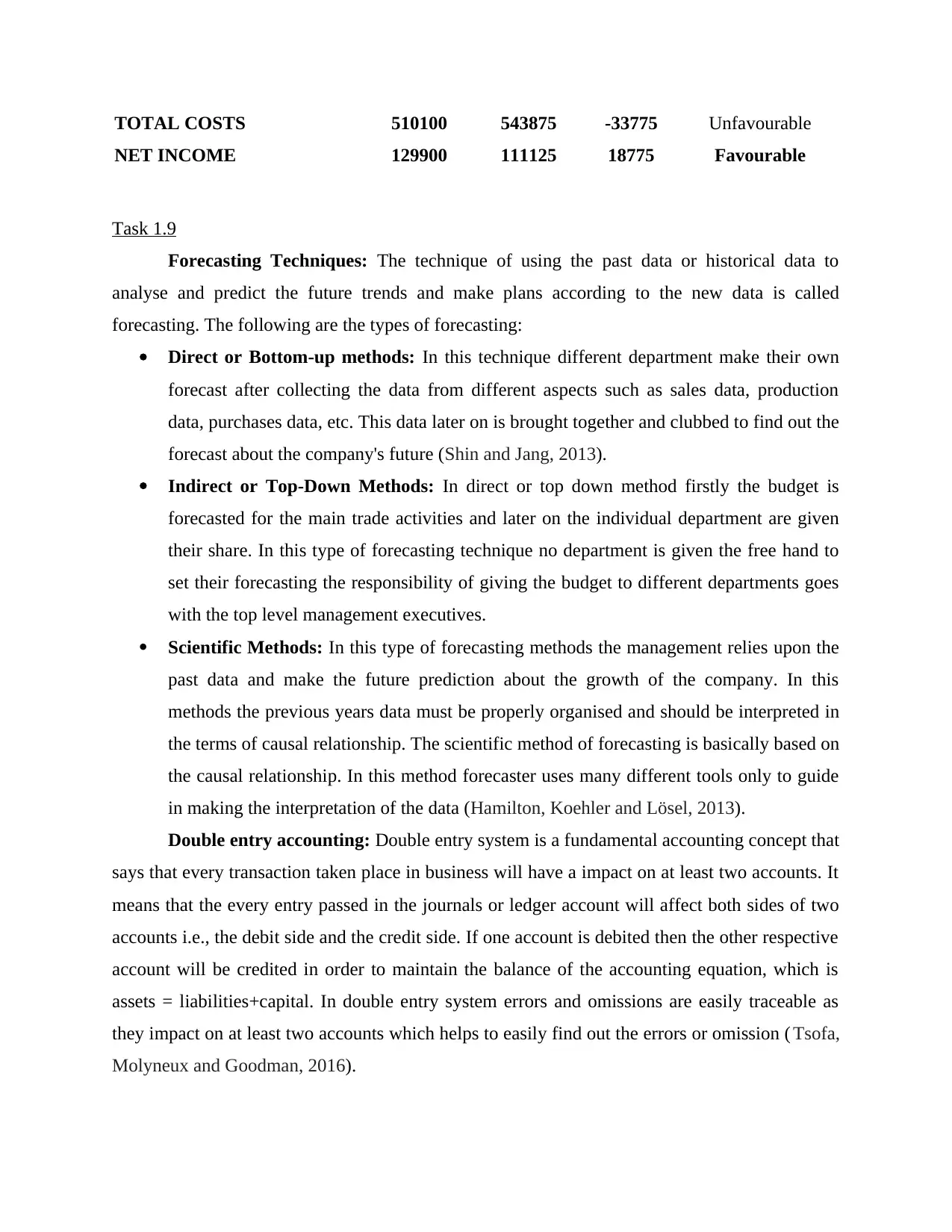
TOTAL COSTS 510100 543875 -33775 Unfavourable
NET INCOME 129900 111125 18775 Favourable
Task 1.9
Forecasting Techniques: The technique of using the past data or historical data to
analyse and predict the future trends and make plans according to the new data is called
forecasting. The following are the types of forecasting:
Direct or Bottom-up methods: In this technique different department make their own
forecast after collecting the data from different aspects such as sales data, production
data, purchases data, etc. This data later on is brought together and clubbed to find out the
forecast about the company's future (Shin and Jang, 2013).
Indirect or Top-Down Methods: In direct or top down method firstly the budget is
forecasted for the main trade activities and later on the individual department are given
their share. In this type of forecasting technique no department is given the free hand to
set their forecasting the responsibility of giving the budget to different departments goes
with the top level management executives.
Scientific Methods: In this type of forecasting methods the management relies upon the
past data and make the future prediction about the growth of the company. In this
methods the previous years data must be properly organised and should be interpreted in
the terms of causal relationship. The scientific method of forecasting is basically based on
the causal relationship. In this method forecaster uses many different tools only to guide
in making the interpretation of the data (Hamilton, Koehler and Lösel, 2013).
Double entry accounting: Double entry system is a fundamental accounting concept that
says that every transaction taken place in business will have a impact on at least two accounts. It
means that the every entry passed in the journals or ledger account will affect both sides of two
accounts i.e., the debit side and the credit side. If one account is debited then the other respective
account will be credited in order to maintain the balance of the accounting equation, which is
assets = liabilities+capital. In double entry system errors and omissions are easily traceable as
they impact on at least two accounts which helps to easily find out the errors or omission ( Tsofa,
Molyneux and Goodman, 2016).
NET INCOME 129900 111125 18775 Favourable
Task 1.9
Forecasting Techniques: The technique of using the past data or historical data to
analyse and predict the future trends and make plans according to the new data is called
forecasting. The following are the types of forecasting:
Direct or Bottom-up methods: In this technique different department make their own
forecast after collecting the data from different aspects such as sales data, production
data, purchases data, etc. This data later on is brought together and clubbed to find out the
forecast about the company's future (Shin and Jang, 2013).
Indirect or Top-Down Methods: In direct or top down method firstly the budget is
forecasted for the main trade activities and later on the individual department are given
their share. In this type of forecasting technique no department is given the free hand to
set their forecasting the responsibility of giving the budget to different departments goes
with the top level management executives.
Scientific Methods: In this type of forecasting methods the management relies upon the
past data and make the future prediction about the growth of the company. In this
methods the previous years data must be properly organised and should be interpreted in
the terms of causal relationship. The scientific method of forecasting is basically based on
the causal relationship. In this method forecaster uses many different tools only to guide
in making the interpretation of the data (Hamilton, Koehler and Lösel, 2013).
Double entry accounting: Double entry system is a fundamental accounting concept that
says that every transaction taken place in business will have a impact on at least two accounts. It
means that the every entry passed in the journals or ledger account will affect both sides of two
accounts i.e., the debit side and the credit side. If one account is debited then the other respective
account will be credited in order to maintain the balance of the accounting equation, which is
assets = liabilities+capital. In double entry system errors and omissions are easily traceable as
they impact on at least two accounts which helps to easily find out the errors or omission ( Tsofa,
Molyneux and Goodman, 2016).
Paraphrase This Document
Need a fresh take? Get an instant paraphrase of this document with our AI Paraphraser
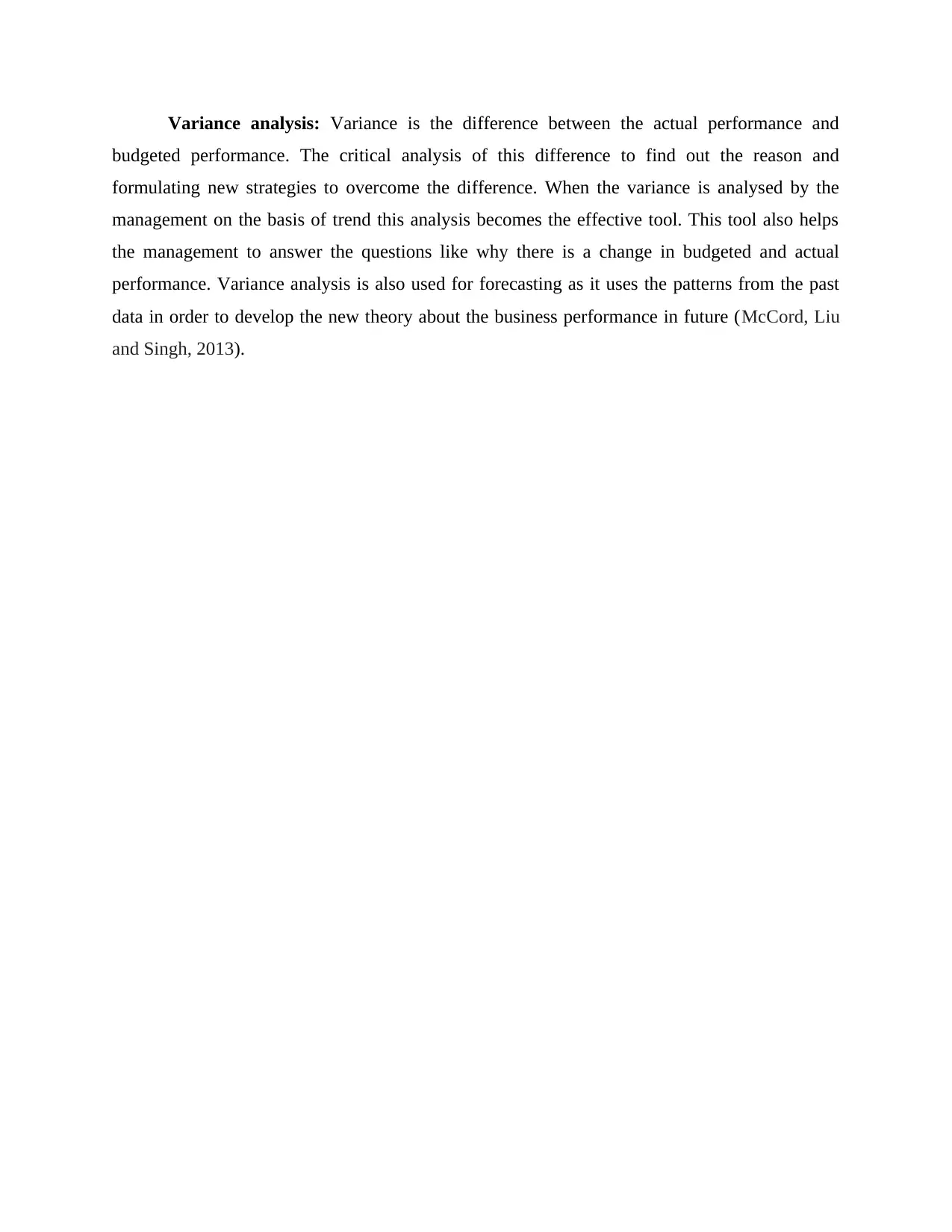
Variance analysis: Variance is the difference between the actual performance and
budgeted performance. The critical analysis of this difference to find out the reason and
formulating new strategies to overcome the difference. When the variance is analysed by the
management on the basis of trend this analysis becomes the effective tool. This tool also helps
the management to answer the questions like why there is a change in budgeted and actual
performance. Variance analysis is also used for forecasting as it uses the patterns from the past
data in order to develop the new theory about the business performance in future (McCord, Liu
and Singh, 2013).
budgeted performance. The critical analysis of this difference to find out the reason and
formulating new strategies to overcome the difference. When the variance is analysed by the
management on the basis of trend this analysis becomes the effective tool. This tool also helps
the management to answer the questions like why there is a change in budgeted and actual
performance. Variance analysis is also used for forecasting as it uses the patterns from the past
data in order to develop the new theory about the business performance in future (McCord, Liu
and Singh, 2013).
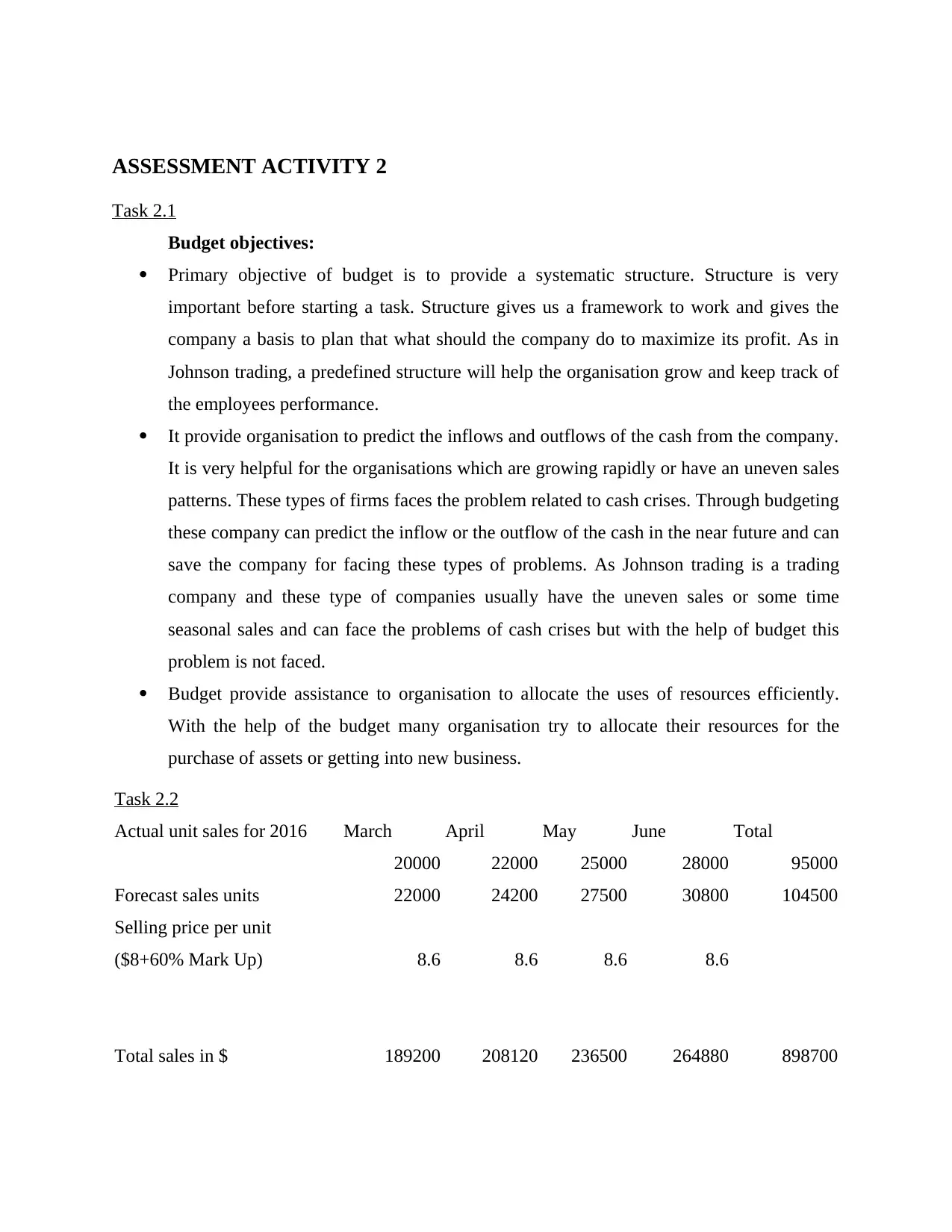
ASSESSMENT ACTIVITY 2
Task 2.1
Budget objectives:
Primary objective of budget is to provide a systematic structure. Structure is very
important before starting a task. Structure gives us a framework to work and gives the
company a basis to plan that what should the company do to maximize its profit. As in
Johnson trading, a predefined structure will help the organisation grow and keep track of
the employees performance.
It provide organisation to predict the inflows and outflows of the cash from the company.
It is very helpful for the organisations which are growing rapidly or have an uneven sales
patterns. These types of firms faces the problem related to cash crises. Through budgeting
these company can predict the inflow or the outflow of the cash in the near future and can
save the company for facing these types of problems. As Johnson trading is a trading
company and these type of companies usually have the uneven sales or some time
seasonal sales and can face the problems of cash crises but with the help of budget this
problem is not faced.
Budget provide assistance to organisation to allocate the uses of resources efficiently.
With the help of the budget many organisation try to allocate their resources for the
purchase of assets or getting into new business.
Task 2.2
Actual unit sales for 2016 March April May June Total
20000 22000 25000 28000 95000
Forecast sales units 22000 24200 27500 30800 104500
Selling price per unit
($8+60% Mark Up) 8.6 8.6 8.6 8.6
Total sales in $ 189200 208120 236500 264880 898700
Task 2.1
Budget objectives:
Primary objective of budget is to provide a systematic structure. Structure is very
important before starting a task. Structure gives us a framework to work and gives the
company a basis to plan that what should the company do to maximize its profit. As in
Johnson trading, a predefined structure will help the organisation grow and keep track of
the employees performance.
It provide organisation to predict the inflows and outflows of the cash from the company.
It is very helpful for the organisations which are growing rapidly or have an uneven sales
patterns. These types of firms faces the problem related to cash crises. Through budgeting
these company can predict the inflow or the outflow of the cash in the near future and can
save the company for facing these types of problems. As Johnson trading is a trading
company and these type of companies usually have the uneven sales or some time
seasonal sales and can face the problems of cash crises but with the help of budget this
problem is not faced.
Budget provide assistance to organisation to allocate the uses of resources efficiently.
With the help of the budget many organisation try to allocate their resources for the
purchase of assets or getting into new business.
Task 2.2
Actual unit sales for 2016 March April May June Total
20000 22000 25000 28000 95000
Forecast sales units 22000 24200 27500 30800 104500
Selling price per unit
($8+60% Mark Up) 8.6 8.6 8.6 8.6
Total sales in $ 189200 208120 236500 264880 898700
⊘ This is a preview!⊘
Do you want full access?
Subscribe today to unlock all pages.

Trusted by 1+ million students worldwide
1 out of 16
Related Documents
Your All-in-One AI-Powered Toolkit for Academic Success.
+13062052269
info@desklib.com
Available 24*7 on WhatsApp / Email
![[object Object]](/_next/static/media/star-bottom.7253800d.svg)
Unlock your academic potential
Copyright © 2020–2025 A2Z Services. All Rights Reserved. Developed and managed by ZUCOL.





